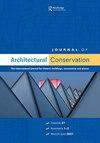Sub-Arctic architecture in detail. Erskine’s disappearing architectural and constructional legacy in Kiruna
IF 1
3区 艺术学
0 ARCHITECTURE
引用次数: 0
Abstract
ABSTRACT The focus of this article is the critical comparative analysis of three projects by Ralph Erskine realised between the 1950s and early 1960s in the municipality of Kiruna. The analysed projects offer the possibility to understand and discuss the extent to which architectural technology and typology could be developed for adapting modern design and ideals to the sub-Arctic climate conditions. Purpose of the presented research is the argumentation of the heritage value and conservation state of the selected designs in relation to Erskine's architectural vision. Considering that in the near future only one fragment of one of the three buildings will be preserved, the research contributes to passing on their legacy to future generations. The issues emerged from the attempt to assess the heritage value of the design and construction processes behind the buildings, stimulate further debate about the multiple perspectives of the practice of architectural conservation.亚北极建筑的细节。厄斯金在基律纳正在消失的建筑遗产
摘要本文的重点是对拉尔夫·厄斯金在20世纪50年代至60年代初在基鲁纳市实施的三个项目的批判性比较分析。所分析的项目提供了了解和讨论建筑技术和类型的可能性,以使现代设计和理想适应亚北极气候条件。本研究的目的是根据厄斯金的建筑愿景,论证所选设计的遗产价值和保护状态。考虑到在不久的将来,三座建筑中只有一座的碎片会被保留下来,这项研究有助于将它们的遗产传给后代。在试图评估建筑背后的设计和施工过程的遗产价值时出现的问题,引发了关于建筑保护实践的多角度的进一步辩论。
本文章由计算机程序翻译,如有差异,请以英文原文为准。
求助全文
约1分钟内获得全文
求助全文

 求助内容:
求助内容: 应助结果提醒方式:
应助结果提醒方式:


